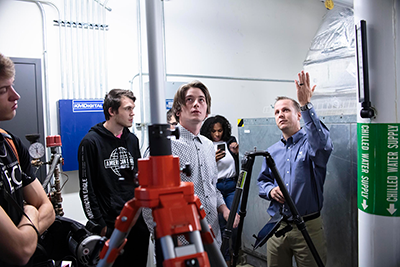
REAL WORLD: STEM LLC students went the the Fort Smith Regional Airport to learn about engineering and architecture.
STEM Living Learning
Written By: Dr. Judith Hansen
Living and Learning Together
STEM people – that is, people who study or work in the fields of science, technology, engineering, and mathematics – like to perform tests and measure results.
Measuring the results of the first year of the STEM Living Learning Community highlights some impressive successes.
Forming the STEM LLC at UAFS was the brainchild of former STEM dean Dr. Ron Darbeau, who hoped it would result in improved recruitment, retention, and academic performance. It took shape over the summer of 2019 and started with first-year students that August. The students, whose majors ran the gamut of STEM concentrations, lived together, sometimes played together, and ideally learned together.
The results, shown by interim Stem dean Dr. Linus Yu, showed that 91 percent of students in the LLC registered for a second year at UAFS. That’s 5 percent more than other STEM students in the Lion’s Den dormitory, and 20 percent higher than non-STEM students in the Lion’s Den.
The LLC students earned a respectable 3.42 grade point average while completing a knock-your-socks-off 48 hours of credit. That compares to 40 for other STEM students in the Lion’s Den and 36 for other students in the Lion’s Den.
Yu said the objectives of the STEM LLC are:
- Creating a community that fosters organic study groups among students with similar courses.
- Providing interaction for students with peers in similar fields of study.
- Meeting students where they are for tutoring and office hours.
- Developing relationships through frequent contact with faculty members.
- Fostering leadership opportunities.
Shanna Turney, who worked closely with the students and their families, said she hoped to create a sense of community among the students.
“We really want this to be seen as a team environment and let the students see that as a group, we are a team, and we want to help you grow into the person you want to be,” Turney said.
The students went on field trips over the course of the year – the last one was on Zoom – exploring the jobs available to STEM graduates.
Thanks to Morrison-Shipley Engineers, Inc., in October, students visited the Fort Smith Regional Airport, where they learned about a mapping tool that scans a room to determine the best place for an object from an architectural and engineering point of view.
They also enjoyed a field trip to the Arkansas College of Osteopathic Medicine, explored the science of cooking with chemistry by using dry ice to make ice cream, had a mingling opportunity with STEM faculty, and relaxed with a December De-Stress Fest, complete with coloring and puppies.
The second year of the LLC started with some changes. One change added a component Turney advocated during the first year: “Typically, (LLC students) have a common class so they can study together and learn together.”
This year, Yu said, the STEM curriculum has added a “zero level, zero-credit course” to build community. The course poses thorny questions to encourage the students to see issues from a new perspective and work together to solve problems.
Perhaps the main thing Yu hopes students get from their involvement is learning that they can count on each other and that the faculty will support them.
“We know that if they get involved in activities on campus and make connections with faculty, they will do better,” Yu said.
Like almost everything else, the STEM LLC has had to make some accommodations because of COVID-19. There are fewer students because many do not want to live on campus right now. And it is challenging to plan activities, especially field trips. Still, Yu believes, providing opportunities like special tutoring and faculty office hours in the dorm will help students remain enrolled and succeed in their courses.
Asked if he thinks other colleges might successfully create other living and learning communities, Yu says yes immediately, then takes half a step back. “Well, we do have a challenging curriculum, and that helps the cohort become a team.”
But in the middle of the spring 2020 semester, Turney was more positive. She hopes other colleges will create communities because they build relationships, and “relationships are contagious.”
- Tags:
- STEM
